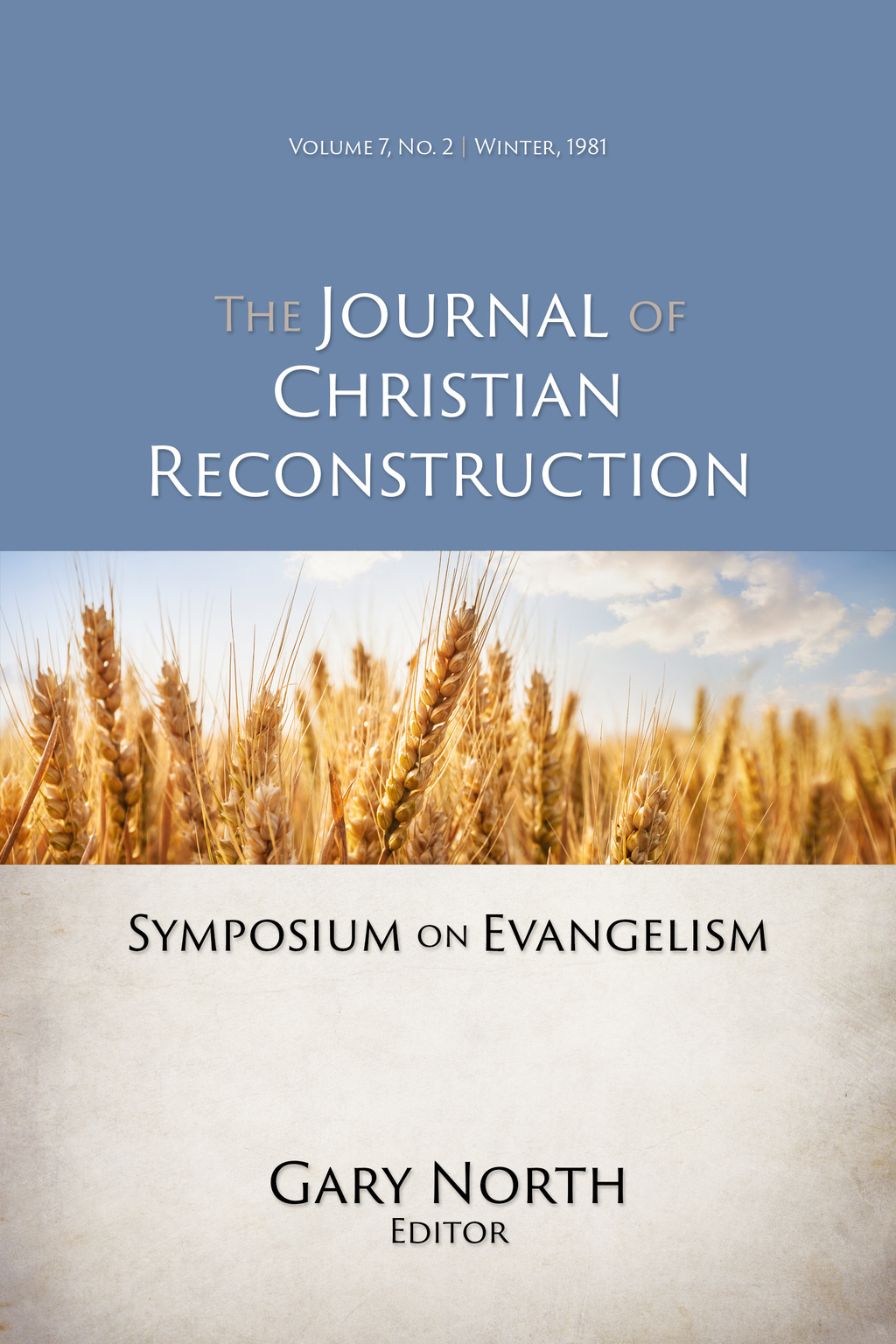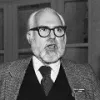
JCR Vol. 07 No. 02: Symposium on Evangelism
What’s wrong with Reformed evangelism? Something certainly appears to be wrong. When we look at the growth of Arminian Baptist churches and compare this growth with the various Reformed Baptist and Presbyterian denominations, the numbers are very discouraging. When J. Gresham Machen left the old Presbyterian Church of the USA, he believed that his newly formed Presbyterian Church of America would grow rapidly as a result of its commitment to biblical inerrancy and the fundamentals of the faith. Instead, it suffered a split the next year (June 1937), and the two new denominations, the Bible Presbyterians and Orthodox Presbyterians, have not grown much in membership since 1937.
eBook

- R. J. Rushdoony
- , Kenneth L. Gentry, Jr., Th.D.
- View More Authors
- Herbert Bowsher
- Francis E. Mahafly
- Jefferson G. Duckett
- James B. Jordan
- Gary North
- Lewis Edwards Bulkeley
- Donovan A. Courville
- Richard Flinn
- Tommy W. Rogers
What’s wrong with Reformed evangelism? Something certainly appears to be wrong. When we look at the growth of Arminian Baptist churches and compare this growth with the various Reformed Baptist and Presbyterian denominations, the numbers are very discouraging. When J. Gresham Machen left the old Presbyterian Church of the USA, he believed that his newly formed Presbyterian Church of America would grow rapidly as a result of its commitment to biblical inerrancy and the fundamentals of the faith. Instead, it suffered a split the next year (June 1937), and the two new denominations, the Bible Presbyterians and Orthodox Presbyterians, have not grown much in membership since 1937.
Much the same has been true of the various Dutch-based Reformed denominations. They grow only if the birth rate increases, and the death rate decreases within the respective groups. As I noted (at age 21), the Dutch churches seem to have substituted procreation for a Board of Home Missions. (I wasn’t tactful in my youth, the way I am today.)
So what’s the problem? As you might expect, there is more than one problem. There is a whole pile of problems, such as: 1) not systematic evangelism programs; 2) imitation Arminian evangelism programs; 3) ineffective evangelism programs; 4) a message geared to confrontation, not conquest; 5) the humanism of our era; 6) lack of capital; 7) lack of confidence; 8) lack of past successes to serve as precedents; 9) seminaries that don’t emphasize evangelism; 10) too much concern for the rigors of theological speculation, and not enough for the demands of applied theology; 11) an inability to recognize and emphasize the strong points of the Reformed heritage (relevance, concrete answers for social problems, scholarship, organization; 12) fatalism regarding stagnation and defeat; 13) ignorance of the warfare between Christianity and humanism; 14) compromised apologetic methodology (rationalism); 15) a constricted view of the Kingdom of God; 16) incompetence in the area of communication; 17) a failure to tithe.
One of the criticisms that has been aimed at the Christian reconstructionist movement is that it has not been concerned with evangelism. An odd charge, coming from pastors who have never demonstrated that they have had any grasp of evangelism techniques, given their tiny churches and invisibility in their communities. The Christian reconstruction movement is less than a decade old. It has little capital. Yet despite its youth and its lack of capital, it has been influential enough to become a force in American thought and culture. When Newsweek identified the source of the “religious right’s” ideas, it listed Chalcedon, and only Chalcedon (Feb. 2, 1981, p. 60). But this is not “evangelism” in the eyes of the critics. This doesn’t count. So what does count? Not sheer numbers, certainly; the critics cannot point to their own success using this criterion. What is the nature of legitimate evangelism?
The latest issue of The Journal of Christian Reconstruction addresses itself to this important question. But more than this: it offers specific, affordable suggestions to struggling congregations about how they can grow, become more influential, and count for something within their communities. We need both a theory of evangelism and a practical program for evangelism. The “Symposium on Evangelism” offers both.
There has been an enormous waste in virtually all popular programs of evangelism. They have not been cost-effective. They have not targeted their audiences properly. They have not been geared to repeated contacts. They have not been structured in terms of long-range objectives—objectives stretching out two or more generations. The evangelism programs popular (if that word can even be used) in Reformed circles have generally been warmed-over versions of Arminian evangelism. These techniques have not worked for Reformed churches, yet the pastors have not been willing to scrap them and rethink the whole question.
Is there a distinctively Reformed evangelism? Are its techniques fundamentally different from those employed by Arminian churches? Is there a distinctively Christian reconstructionist evangelism—a type of evangelism unavailable to the majority of Arminian denominations and congregations? The answer to all three questions is the same: Yes. The Journal provides the evidence.
Far from being unconcerned with evangelism, the Chalcedon movement is vitally concerned with evangelism. It is a small movement at present, and it needs capital. How can it expect to become a world-wide force for social change if it neglects evangelism? How can its perspective spread to the decision-makers of this age, except by evangelism? Everyone needs evangelism; the Arminians, the introspective Reformed groups, the traditional conservatives, the Roman Catholics, the universities, the heathen seats of power, the media, the Iron Curtain nations, and all points in between. But the average pastor faces more immediate problems. He has to build up his struggling congregation. He needs to take the first steps. That’s why we have devoted an issue of the Journal to evangelism.
What distinguishes the Chalcedon movement’s view of evangelism from the rival varieties that are common today, is the scope of evangelism. We are convinced that no evangelism program can hope to succeed unless it is driven by a vision of universal conquest. The three strongest political forces in the world today are Marxism, militant Islam, and modern science. All three are predestinarian. All three are officially optimistic. All three believe that they possess the key which will unlock the door of history. All three believe that they have access to the true law structure which will give them power over the world. All three see themselves as agents of historical and social change. All three see the whole world as their proper and required domain. Until Christians can match them, doctrine for doctrine, vision for vision, we will sit on the sidelines of history, cheering for no one in particular. Waiting for the “game” to end so that we can go home. That’s what most Christians are doing now. This produces an ineffective evangelism. It produces a socially irrelevant witness. It produces the kind of witness the Roman emperors would have preferred to see the early church proclaim. The “emperors” of our day can live with this sort of witness, too. It is time to change both our strategy and our tactics.—Gary North

- R. J. Rushdoony
Rev. R.J. Rushdoony (1916–2001), was a leading theologian, church/state expert, and author of numerous works on the application of Biblical law to society. He started the Chalcedon Foundation in 1965. His Institutes of Biblical Law (1973) began the contemporary theonomy movement which posits the validity of Biblical law as God’s standard of obedience for all. He therefore saw God’s law as the basis of the modern Christian response to the cultural decline, one he attributed to the church’s false view of God’s law being opposed to His grace. This broad Christian response he described as “Christian Reconstruction.” He is credited with igniting the modern Christian school and homeschooling movements in the mid to late 20th century. He also traveled extensively lecturing and serving as an expert witness in numerous court cases regarding religious liberty. Many ministry and educational efforts that continue today, took their philosophical and Biblical roots from his lectures and books.
- Kenneth L. Gentry, Jr., Th.D.
Kenneth L. Gentry, Jr., holds degrees from Tennessee Temple University (B.A.), Reformed Theological Seminary (M. Div.), and Whitefield Theological Seminary (Th. M.; Th. D). He also attended Grace Theological Seminary for two years. He is Research Professor in New Testament (Whitefield Theological Seminary), a theological writer, and conference speaker. He has written numerous books and articles on issues such as theology, ecclesiology, eschatology, theonomy, six-day creation, presuppositionalism, worldview, Christian education, and more. He also offers a Christian writing correspondence course. He is the Director of GoodBirth Ministries, a non-profit religious educational ministry committed to sponsoring, subsidizing, and advancing serious Christian scholarship and education. He is a retired Presbyterian minister holding his ordination vows in the Reformed Presbyterian Church, General Assembly.
- Herbert Bowsher
- Francis E. Mahafly
- Jefferson G. Duckett
- James B. Jordan
- Gary North
Dr. Gary North (1942-2022), served as the editor of the Journal of Christian Reconstruction from 1974-81. He is the noted author of scores of articles and over thirty books on economics and history. He served as editor for GaryNorth.com and The Tea Party Economist and was the Director of Curriculum Development for the Ron Paul Curriculum.
- Lewis Edwards Bulkeley
- Donovan A. Courville
- Richard Flinn
- Tommy W. Rogers